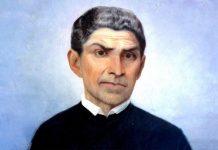“Daughter, you will not die. You will found a great religious order with the title of the Immaculate Conception; its daughters will wear a habit similar to my robes and will dedicate themselves to serving God, in union with Me.”
Newsroom(18/08/2021 10:05, Gaudium Press) Dom Rui Gomes da Silva, a brave Portuguese knight, took part in the capture of Ceuta and remained in Portuguese territory in Africa as mayor of the frontier village of Campo Maior. As a reward for his heroism and courage, he received in marriage Dona Isabel de Menezes, daughter of the Count of Vila Real, an illustrious descendant of the first Portuguese monarch, Dom Afonso Henriques.
Within this marriage was born Beatrice da Silva Menezes, the eighth daughter of the noble couple, in 1426. The elevated Dona Isabel united the singular virtues of wife and mother, and with a deep Catholic sense educated her large family.
Calm and innocence until she was 23 years old
From an early age, Beatrice demonstrated exceptional qualities: docility, uprightness of conscience, inclination for the virtues, and an attraction to the elevated and spiritual things. On a certain occasion, her father ordered a painting of the Most Holy Virgin. Chosen to pose as the model, Beatrice remained the whole time with her eyes lowered in humility. The painting still exists and is known as the Virgin With the Closed Eyes.
Until the age of 23, she lived quietly with her family, but in 1447, her life underwent a great change. The princess Dona Isabel, her 19 year old cousin, was preparing to marry Don John II of Castile and invited Beatrice to be her lady in the Spanish court.
Beatrice entrusted to the Most Holy Virgin the circumstances related to this invitation. Although the dogma of the Immaculate Conception was not yet defined, she preferred to invoke Our Lady under the title of The Immaculate.
Never were honors, social position, or a place of prominence at court important to her; her main concern was to glorify God.
Unsullied virtue in the midst of the dangers of the court
Beatrice thus went to the court, but found a very different environment from the one in which she had previously lived. She too was vulnerable to ambition, intrigues, hidden envies, competitions, and comparisons.
Beatrice possessed extraordinary beauty, dignity and gentleness. All those around her confirmed that they had never seen a more beautiful noblewoman in the lands of Spain and Portugal. As a result, she received innumerable compliments from the other ladies, as well as from the gentlemen.
Yet she was elevated, above all, by the beauty of her spirit. Her greatness of soul kept her above all worldly futility and, at the same time, enabled her to be compassionate and kind to all, but not to those who could divert her from the straight path.
Victim of the sovereign’s jealousy
Three years had passed since Beatrice’s arrival at court and her virtues, which had previously evoked admiration, had become a cause of jealousy and envy – vices from which even Queen Isabel was not immune.
Malicious rumors began to cast doubt on the virtues of Beatrice, because King Dom John II – a man of timid and insecure character – sought in his elevated conversations with Beatrice, encouragement to govern his kingdom. There arose, then, in Queen Isabel, fanciful ideas about the conjugal fidelity of her husband.
Seized by a deep hatred, she began in every way to mistreat Beatrice. In addition to scolding her severely in public, she isolated her from the group of noble ladies and showed her contempt by harsh and cutting words.
Although the Saint endured all of this condescending behaviour with exemplary humility, even redoubling her demonstrations of love and fidelity to the Queen, the latter decided once and for all to get rid of her.
One night, having retired wearily to her rooms, Beatrice shed abundant tears at the feet of an image of Our Lady, imploring Her strength to remain faithful in that difficult situation and to fulfill the call that she felt in the depth of the soul.
Soon afterwards, she heard a loud knock at the door and wondered who it could be at that late hour. It was Dona Isabel, glaring wildly, holding a lantern in one hand.
“Follow me!”, commanded the sovereign in a cold voice. The young lady left her chambers and followed the Queen who walked rapidly towards the lower part of the castle.
They crossed long corridors and descended the huge staircase that led underground. The darkness there was complete, the walls were cold and damp, and Beatrice feared the Sovereign’s intentions. The latter stopped before an old vault, tall and very narrow, and, with a sarcastic laugh, said:
“You have fooled me thus far! You intend to conquer the King, get rid of me, and ascend the throne of Castile…you will not succeed! Get in, or I will throw you in myself.”
Staring at her firmly, Beatrice said,
“Lady, you wish to kill me, but know that I am innocent of the accusations you make. God, the just Judge, is witness to your act. May He forgive your folly, my cousin, and give you the grace of repentance to purify your soul.”
Dona Isabel pushed her violently into the vault, slammed the door and locked it with a large key, waiting for the lack of oxygen to take the life of her beautiful “rival”.
In dread and darkness shines the Immaculate
The noble lady found herself without any possibility of salvation. She would die without the Sacraments, without receiving help from anyone, in a slow and terrifying agony; she was already struggling to breathe. Only Heaven could help her now, and in confidence, she turned to Our Lady:
“O Mary Immaculate, help me!” Instantly, Our Lady appeared to Her, more radiant than the sun, dressed in white with a blue mantle, holding the Child Jesus in Her arms.
“My daughter, you shall not die. I will preserve your life so that you may accomplish what you have so longed for. You will found a great religious order under the title of the Immaculate Conception; its daughters will wear a habit similar to my garments, and will dedicate themselves to serving God, in union with Me.”“
Enraptured by the vision, Beatrice remained three days in the vault, filled with consolation and joy, with no sense of passing time.
Her uncle, Don João de Menezes, who also resided at the court, noticing his niece’s absence, asked Dona Isabel for news of her. The Queen led him to the vault, where she expected to find a corpse. Imagine her surprise, when, upon opening the door, Beatrice emerged even more beautiful than before, sparkling like a diamond!
Preparation for the great foundation
Beatrice forgave her Lady, who had repented, but she decided to leave the intrigues of the court and seek refuge in the monastery of Saint Dominic el Real, in Toledo.
In those days, it was common for convents to host people of high ranking who, without an obligation to follow the Rule, led a monastic life there. It was this style of life that Beatrice longed for. She would no longer serve a queen of the earth, but the Queen of Heaven.
Doña Isabel, in reparation for what she had done, had prepared everything necessary for Beatrice’s arduous and risky journey. On the way there, Beatrice met two Franciscan friars who spoke to her prophetically about the future of her foundation. When, however, she invited them to dine with her entourage at the next inn, they disappeared from sight.
She then understood that she had been accompanied by Saint Francis of Assisi and Saint Anthony of Lisbon, strengthening and encouraging her to continue with her undertaking!
After crossing the threshold of the cloister of the monastery of Saint Dominic, this noble lady covered her face with a white veil which she would wear until the end of her life to hide her beauty from men and to offer it only to God. Never again would that beautiful physiognomy, which would preserve its youth and beauty until death, be contemplated by creatures.
The silence, the recollection, and the ceremonial prepared her to face the difficulties that would be the basis of her foundation: the vision which she had contemplated inside the blessed vault remained with her.
When would the day come to wear that white and blue habit, the symbol of the Immaculate Conception?
The fruits of a long wait
Great patience foretells that God will be generous at the moment of giving. More than thirty years had passed… wearing a religious habit, Beatrice, a simple guest in the monastery, behaved so perfectly as a religious that the nuns took her as an example.
In 1484 an important visitor arrived at the monastery. It was the Queen Isabel, the Catholic, daughter and successor of the Queen who had wanted to take Beatrice’s life. She had come to ask for prayers for the political situation of her kingdom.
At the end of the conversation, the Sovereign, very committed to helping Beatrice in some way, offered her a palace near the Church of the Holy Faith in Toledo, that she might begin her much desired work. Beatrice saw in this offer the hand of Divine Providence: it was the moment!
The Order
The news of the foundation of the new monastery spread quickly throughout the area. Soon several candidates were presented, many from noble families, to join the Franciscan Conceptionist Order, which would be a branch of the Order of the Friars Minor. To all Beatrice gave instruction regarding the austerity of the monastic life, the enclosure, the silence, and the mortification.
Twelve of these young women persevered in their pious desires, including Filipa da Silva, her niece. Beatrice was committed to properly forming her spiritual daughters. Taking as their teacher and model their holy mother superior, they were molded entirely by her great spirit.
They lived in contemplation, dressing privately in a white habit with an image of the Virgin surrounded by rays and crowned with twelve stars, and a blue cloak, girded with the Franciscan hemp cord.
With the foundation of this convent was the Order of the Immaculate established? Not yet. The definitive approval of the institute with its rule, habit, and title of the Immaculate Conception was lacking. It was necessary to request it from the Holy See and the Queen, who enjoyed great esteem with the reigning Pontiff, Innocent VIII, took charge of this.
Some time later, Beatrice was called to the monastery. There was a knight with the news that the Pope had approved her order and that the Bull of approval was already on its way by sea. Joy pervaded the monastery: songs and celebrations!
But a few days later, the same knight returned with tragic news: the ship had sunk and the Bull was lost.
Beatrice felt a heavy blow. Was this a sign from Providence? She stood before the tabernacle, praying for her order. Her daughters, keeping vigil, prayed with her. They remained in unshakeable confidence, certain that the Blessed Virgin would not leave unfinished the work that She had begun. But it was a delay the length of which they could not imagine.
Trust breeds a miracle
After three days of prayers, the holy mother opened the drawer of a piece of furniture, of which she alone had the key, and found a rolled up parchment that she had never seen before. She felt a strong smell of the sea and her heart shuddered: “My God, this looks like the Papal Bull“. She picked it up and noticed a seal hanging from a thread; she unwrapped it a bit and could read some words in Latin: it had all the characteristics of a Bull.
To make sure that it was really a miracle, Beatrice sent the document to the bishop for his opinion: it was the Bull Inter Universa, with the pontifical approval of the Order, dated 30 April 1489! It became known as the “Bull of the Miracle”.
Beatrice had been a devotee of the Archangel Raphael since childhood, and she was completely convinced that the knight who had brought her the news of the Bull was in fact the Archangel, and that Saint Raphael had also recovered the document from the waters!
True Renunciation
In August 1490, when the religious sisters were making the preparatory retreat for the solemn profession of vows and the official reception of the habit, the Virgin Mary appeared to the holy Foundress and said to her:
“Daughter, it is not my will, nor that of my Son, that you should enjoy here on earth what you have so desired. In ten days you will come with me to Paradise.”
Beatrice fell ill, and revealed to her confessor the vision she had seen. She remained always calm and confident, offering to God what had been most dear to her: the accomplishment of her work.
She received the habit and made the much desired vows. To receive the Sacrament of the Anointing of the Sick, it was necessary to uncover her face, and all could then contemplate a brilliant star that shone on her forehead and was reflected in her smile. This star remained present until the Saint breathed her last. It was August 16, 1491.
The star of the Immaculate Conception continues to shine in the skies of the Church
The echoes of her holiness, which were already heard during her lifetime, spread much further after her death. The very permanence of the new Order, which rapidly expanded amidst tremendous difficulties, is proof of her intercession.
Pope Paul VI canonized her in October 1976.
The humble tree born in the darkness of a vault would extend its branches over the whole earth and shelter under its protective shade the souls eager to serve Her who is “fair as the moon, bright as the sun, and terrible as an army in battle array” (Ct 6,10).
Text taken, with minor adaptations, from the magazine Heralds of the Gospel, n. 84, December 2008.
Compiled by Sandra Chisholm


































